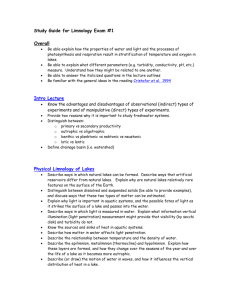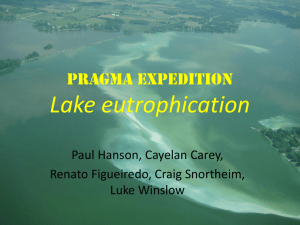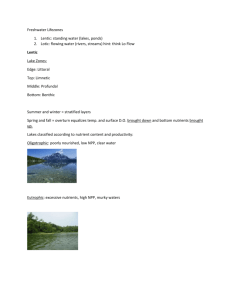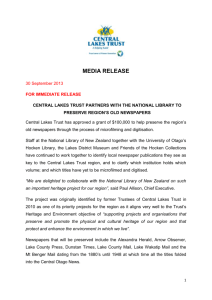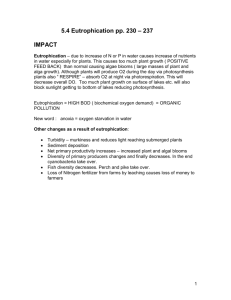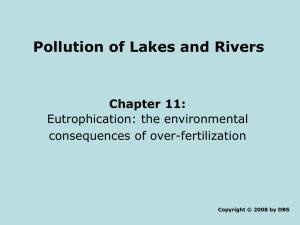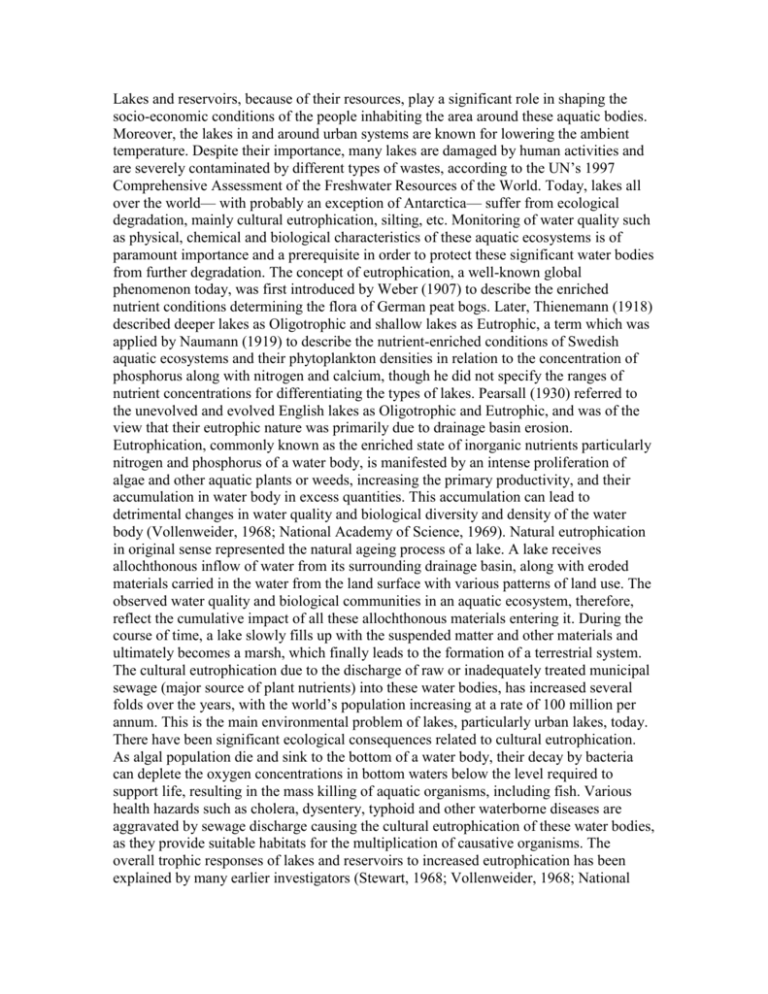
Lakes and reservoirs, because of their resources, play a significant role in shaping the
socio-economic conditions of the people inhabiting the area around these aquatic bodies.
Moreover, the lakes in and around urban systems are known for lowering the ambient
temperature. Despite their importance, many lakes are damaged by human activities and
are severely contaminated by different types of wastes, according to the UN’s 1997
Comprehensive Assessment of the Freshwater Resources of the World. Today, lakes all
over the world— with probably an exception of Antarctica— suffer from ecological
degradation, mainly cultural eutrophication, silting, etc. Monitoring of water quality such
as physical, chemical and biological characteristics of these aquatic ecosystems is of
paramount importance and a prerequisite in order to protect these significant water bodies
from further degradation. The concept of eutrophication, a well-known global
phenomenon today, was first introduced by Weber (1907) to describe the enriched
nutrient conditions determining the flora of German peat bogs. Later, Thienemann (1918)
described deeper lakes as Oligotrophic and shallow lakes as Eutrophic, a term which was
applied by Naumann (1919) to describe the nutrient-enriched conditions of Swedish
aquatic ecosystems and their phytoplankton densities in relation to the concentration of
phosphorus along with nitrogen and calcium, though he did not specify the ranges of
nutrient concentrations for differentiating the types of lakes. Pearsall (1930) referred to
the unevolved and evolved English lakes as Oligotrophic and Eutrophic, and was of the
view that their eutrophic nature was primarily due to drainage basin erosion.
Eutrophication, commonly known as the enriched state of inorganic nutrients particularly
nitrogen and phosphorus of a water body, is manifested by an intense proliferation of
algae and other aquatic plants or weeds, increasing the primary productivity, and their
accumulation in water body in excess quantities. This accumulation can lead to
detrimental changes in water quality and biological diversity and density of the water
body (Vollenweider, 1968; National Academy of Science, 1969). Natural eutrophication
in original sense represented the natural ageing process of a lake. A lake receives
allochthonous inflow of water from its surrounding drainage basin, along with eroded
materials carried in the water from the land surface with various patterns of land use. The
observed water quality and biological communities in an aquatic ecosystem, therefore,
reflect the cumulative impact of all these allochthonous materials entering it. During the
course of time, a lake slowly fills up with the suspended matter and other materials and
ultimately becomes a marsh, which finally leads to the formation of a terrestrial system.
The cultural eutrophication due to the discharge of raw or inadequately treated municipal
sewage (major source of plant nutrients) into these water bodies, has increased several
folds over the years, with the world’s population increasing at a rate of 100 million per
annum. This is the main environmental problem of lakes, particularly urban lakes, today.
There have been significant ecological consequences related to cultural eutrophication.
As algal population die and sink to the bottom of a water body, their decay by bacteria
can deplete the oxygen concentrations in bottom waters below the level required to
support life, resulting in the mass killing of aquatic organisms, including fish. Various
health hazards such as cholera, dysentery, typhoid and other waterborne diseases are
aggravated by sewage discharge causing the cultural eutrophication of these water bodies,
as they provide suitable habitats for the multiplication of causative organisms. The
overall trophic responses of lakes and reservoirs to increased eutrophication has been
explained by many earlier investigators (Stewart, 1968; Vollenweider, 1968; National
Academy of Science, 1969; Lee, 1971; Welch, 1980; OECD, 1982). Limnological studies
on different temperate lake ecosystems are in replete (Wetzel, 1975, 2001). Investigations
were carried out on the effects of cultural eutrophication on different limnological
parameters of various lakes, Madison lakes (Sawyer et al., 1945), Lake Washington
(Edmondson, 1961, 1970, 1991), Gull Lake, Lake Michigan (Moss, 1972), Round Lake,
Minnesota (Shapiro & Weight, 1984), Lake Eire (Nicholls & Hopkins, 1993), and central
European lakes (Thomas, 1969), and also on the changes in faunal and floral composition
of natural waters in response to eutrophication (Morgan, 1970; Fanselius, 1977).
Schindler (1975, 1990) probably was the first to carry out investigations on
eutrophication in relation to recovery. There were a few excellent reviews on different
aspects of structure and function of temperate lake ecosystems in relation to
eutrophication, which gave an holistic understanding of their restoration and management
(Hutchinson, 1975; Jorgensen, 1980; Ryding & Rast, 1989; Harper, 1992; Cooke, 1993).
Reddy, M.V.. Restoration and Management of Tropical Eutrophic Lakes.
Enfield, NH, USA: Science Publishers, 2005. p 61.
http://site.ebrary.com/lib/aubg/Doc?id=10256234&ppg=61
Copyright © 2005. Science Publishers. All rights reserved.
Reddy, M.V.. Restoration and Management of Tropical Eutrophic Lakes.
Enfield, NH, USA: Science Publishers, 2005. p 60.
http://site.ebrary.com/lib/aubg/Doc?id=10256234&ppg=60
Copyright © 2005. Science Publishers. All rights reserved.
Reddy, M.V.. Restoration and Management of Tropical Eutrophic Lakes.
Enfield, NH, USA: Science Publishers, 2005. p 59.
http://site.ebrary.com/lib/aubg/Doc?id=10256234&ppg=59
Copyright © 2005. Science Publishers. All rights reserved.

